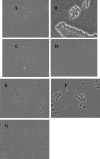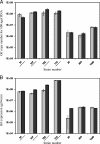Correlation of the capsular phenotype in Propionibacterium freudenreichii with the level of expression of gtf, a unique polysaccharide synthase-encoding gene
- PMID: 20228100
- PMCID: PMC2863425
- DOI: 10.1128/AEM.02591-09
Correlation of the capsular phenotype in Propionibacterium freudenreichii with the level of expression of gtf, a unique polysaccharide synthase-encoding gene
Abstract
Many food-grade bacteria produce exopolysaccharides (EPS) that affect the texture of fermented food products and that may be involved in probiotic properties. Propionibacterium freudenreichii is a Gram-positive food-grade bacterium with reported probiotic capabilities that is widely used as starter in Swiss-type cheese. In this study, 68 strains of P. freudenreichii were screened for the beta-glucan capsular phenotype by immunoagglutination with a specific antibody and for the presence of the gtf gene coding for polysaccharide synthase. All strains were positive for PCR amplification with gtf gene-specific primers, but the presence of beta-glucan capsular EPS was detected for only 35% of the strains studied. Disruption of gtf in P. freudenreichii revealed that gtf is a unique gene involved in beta-glucan capsular EPS production in P. freudenreichii. The gtf gene was transferred into and expressed in Lactococcus lactis, in which it conferred an agglutination-positive phenotype. Expression of the gtf gene was measured by performing quantitative reverse transcription-PCR assays with RNA from four capsular and three noncapsular strains. A positive correlation was found between the beta-glucan capsular phenotype and gtf gene expression. Sequencing of the region upstream of the gtf open reading frame revealed the presence of an insertion element (IS element) in this upstream region in the four strains with the beta-glucan capsular phenotype. The role of the IS element in the expression of neighboring genes and its impact on interstrain variability of the P. freudenreichii capsule phenotype remain to be elucidated.
Figures




Similar articles
-
Capsular exopolysaccharide biosynthesis gene of Propionibacterium freudenreichii subsp. shermanii.Int J Food Microbiol. 2008 Jul 31;125(3):252-8. doi: 10.1016/j.ijfoodmicro.2008.04.006. Epub 2008 Apr 22. Int J Food Microbiol. 2008. PMID: 18524407
-
Contribution of surface β-glucan polysaccharide to physicochemical and immunomodulatory properties of Propionibacterium freudenreichii.Appl Environ Microbiol. 2012 Mar;78(6):1765-75. doi: 10.1128/AEM.07027-11. Epub 2012 Jan 13. Appl Environ Microbiol. 2012. PMID: 22247154 Free PMC article.
-
Exopolysaccharides from co-cultures of Weissella confusa 11GU-1 and Propionibacterium freudenreichii JS15 act synergistically on wheat dough and bread texture.Int J Food Microbiol. 2015 Dec 2;214:91-101. doi: 10.1016/j.ijfoodmicro.2015.07.025. Epub 2015 Jul 23. Int J Food Microbiol. 2015. PMID: 26256717
-
Pediococcus parvulus gtf gene encoding the GTF glycosyltransferase and its application for specific PCR detection of beta-D-glucan-producing bacteria in foods and beverages.J Food Prot. 2006 Jan;69(1):161-9. doi: 10.4315/0362-028x-69.1.161. J Food Prot. 2006. PMID: 16416914
-
New insights into physiology and metabolism of Propionibacterium freudenreichii.Int J Food Microbiol. 2011 Sep 1;149(1):19-27. doi: 10.1016/j.ijfoodmicro.2011.04.026. Epub 2011 May 8. Int J Food Microbiol. 2011. PMID: 21620505 Review.
Cited by
-
Promising immunomodulatory effects of selected strains of dairy propionibacteria as evidenced in vitro and in vivo.Appl Environ Microbiol. 2010 Dec;76(24):8259-64. doi: 10.1128/AEM.01976-10. Epub 2010 Oct 22. Appl Environ Microbiol. 2010. PMID: 20971874 Free PMC article.
-
A Pan-Genome Guided Metabolic Network Reconstruction of Five Propionibacterium Species Reveals Extensive Metabolic Diversity.Genes (Basel). 2020 Sep 23;11(10):1115. doi: 10.3390/genes11101115. Genes (Basel). 2020. PMID: 32977700 Free PMC article.
-
The complete genome of Propionibacterium freudenreichii CIRM-BIA1, a hardy actinobacterium with food and probiotic applications.PLoS One. 2010 Jul 23;5(7):e11748. doi: 10.1371/journal.pone.0011748. PLoS One. 2010. PMID: 20668525 Free PMC article.
-
A temporal-omic study of Propionibacterium freudenreichii CIRM-BIA1 adaptation strategies in conditions mimicking cheese ripening in the cold.PLoS One. 2012;7(1):e29083. doi: 10.1371/journal.pone.0029083. Epub 2012 Jan 13. PLoS One. 2012. PMID: 22253706 Free PMC article.
-
Dairy Propionibacteria: Versatile Probiotics.Microorganisms. 2017 May 13;5(2):24. doi: 10.3390/microorganisms5020024. Microorganisms. 2017. PMID: 28505101 Free PMC article. Review.
References
-
- Allen, P. Z., and W. H. Bowen. 1988. Immunochemical studies on pneumococcal type 37 capsular polysaccharide. Mol. Immunol. 25:1011-1017. - PubMed
-
- Bouglé, D., N. Roland, F. Lebeurrier, and P. Arhan. 1999. Effect of propionibacteria supplementation on fecal bifidobacteria and segmental colonic transit time in healthy human subjects. Scand. J. Gastroenterol. 34:144-148. - PubMed
-
- Deutsch, S.-M., H. Falentin, M. Dols-Lafargue, G. LaPointe, and D. Roy. 2008. Capsular exopolysaccharide biosynthesis gene of Propionibacterium freudenreichii subsp. shermanii. Int. J. Food Microbiol. 125:252-258. - PubMed
-
- Dols-Lafargue, M., H. Y. Lee, C. Le Marrec, A. Heyraud, G. Chambat, and A. Lonvaud-Funel. 2008. Characterization of gtf, a glucosyltransferase gene in the genomes of Pediococcus parvulus and Oenococcus oeni, two bacterial species commonly found in wine. Appl. Environ. Microbiol. 74:4079-4090. - PMC - PubMed
MeSH terms
Substances
Associated data
- Actions
- Actions
- Actions
- Actions
- Actions
- Actions
- Actions
- Actions
- Actions
- Actions
- Actions
- Actions
- Actions
LinkOut - more resources
Full Text Sources
Other Literature Sources
Molecular Biology Databases

